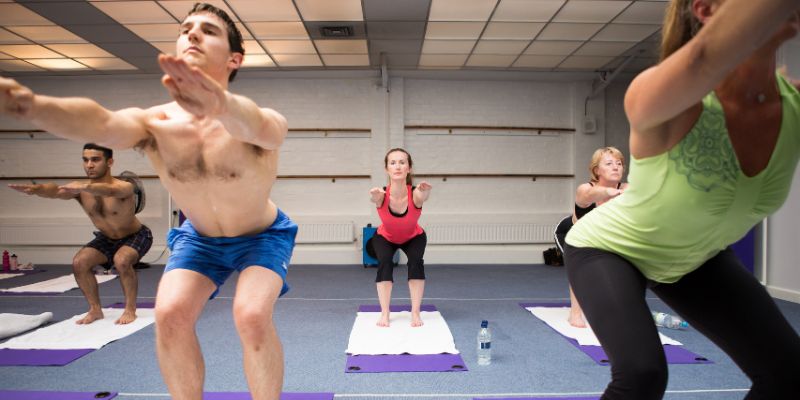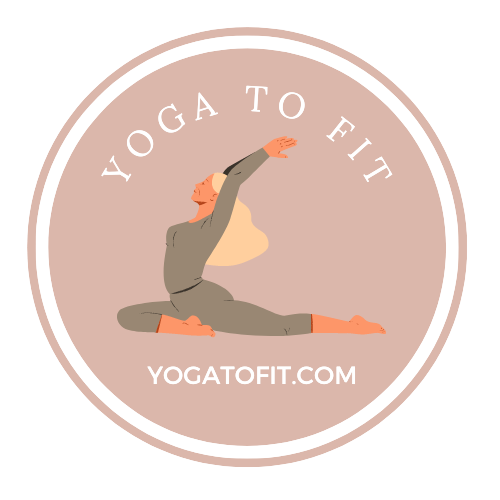Hot Yoga: All you need to know

Over the years, the practice of hot yoga, has grown in popularity. It is a type of yoga pose in a space that is around 105 degrees Fahrenheit hot and 40% humid.
It is thought to have a variety of advantages. It is claimed that this high temperature helps with weight loss, flexibility improvement, and strength and endurance enhancement.
But with the intense heat and physical demands, it’s important to understand the ins and outs of hot yoga before diving in. The right top may greatly enhance your experience by helping you stay cool, dry, and focused while doing it.
Whether you’re an experienced person or a beginner, this easy and step by step guide we will dive into the world of its benefits, practice tips and offer insightful advice on how to get the most of your sessions.
What is Hot Yoga?

It is , also known as Bikram Yoga, is a dynamic yoga practice conducted in a room heated to approximately 105°F (40.6°C) with a humidity level of 40%.
The practice typically consists of a series of 26 postures and two breathing exercises. The heat and humidity create an environment that promotes flexibility, detoxification, and a deep mind-body connection.
Hot yoga uses the concept of heat and exertion to release toxins through sweat. It is less strict with the heat and humidity. The postures — asanas — and sequence can vary from class to class, depending on the yoga instructor’s preparations.
Benefits of Hot Yoga
It offers a large number of physical and mental benefits that keep enthusiasts coming back for more, here are some of them:
Improved Flexibility
The high temperature warms muscles, allowing for deeper stretches and increased flexibility. A 2019 pilot study found that sauna yoga at 122°F (50°C) caused significant improvements in healthy older adults’ flexibility and mild improvements in strength and balance.
Detoxification
Sweating profusely during Hot Yoga aids in flushing out toxins from the body, promoting clearer skin and overall health.
Stress Reduction
The practice encourages mindfulness and relaxation, reducing stress and anxiety levels. Yoga, in general, can help reduce stress levels. A small 2016 study found that Bikram yoga reduced anxiety, and the reduction is directly related to perceived stress.
The high temperature in hot yoga can make it more intense than a traditional yoga class. It makes the heart, muscles, and lungs work harder and boosts metabolism.
It can be an effective heat stress technique to improve plasma volume and cardiovascular performance in elite female field hockey players.
Weight Loss
It can help burn calories and support weight loss efforts when combined with a balanced diet.
Enhanced Circulation
The heat improves blood circulation, promoting cardiovascular health.
Increased Strength
It builds muscle strength, particularly in the core, legs, and upper body.
Many yoga postures are to build strength. A person can hold the pose for at least 60 seconds or more to get into the strength of the muscle.
Examples of such yoga poses are:
- High Plank
- Dolphin
- Chair
Aside from bone strength, supporting body weight while maintaining a pose can help improve bone mineral density.
A 2014 study found that Bikram yoga may preserve and potentially increase bone mineral density in premenopausal women. This makes it an effective measure to prevent osteoporosis.
Improved Posture
Consistent practice helps align the spine and improve posture.
Mental Clarity
It cultivates mental focus and clarity, benefiting both body and mind.
Getting Started with Hot Yoga
:max_bytes(150000):strip_icc()/GettyImages-1203232235-3ddd1e70b0524f93a2153746ae2f78b2.jpg)
If you’re ready to experience the benefits of it, here’s how to get started:
- Find a Studio: Look for a reputable Hot Yoga studio near you. Research their class schedules and instructors to find a good fit.
- Gear Up: You’ll need a few essentials: a yoga mat, a towel, and water. Most studios rent or sell mats and towels if you don’t have your own.
- Dress Comfortably: Opt for moisture-wicking, breathable clothing that allows for movement. Avoid heavy or non-breathable fabrics.
- Hydrate: Drink plenty of water throughout the day leading up to your class to stay hydrated.
- Choose the Right Class: Start with a beginner or introductory class if you’re new to Hot Yoga. These classes are usually less intense and focus on proper technique.
- Arrive Early: Arriving 15-20 minutes before class gives you time to settle in, acclimate to the heat, and let your instructor know if you’re a beginner or have any injuries.
- Listen to Your Body: During class, focus on your breath and listen to your body. It’s okay to take breaks and modify poses as needed.
Practicing Hot Yoga Safely

Hot Yoga is generally safe, but it’s crucial to practice it with awareness and precautions:
- Stay Hydrated: Drink water before, during, and after class to prevent dehydration.
- Respect Your Limits: Avoid pushing yourself too hard. It’s important to challenge yourself, but not to the point of pain or discomfort.
- Watch for Signs of Overheating: Dizziness, nausea, and excessive sweating can be signs of overheating. If you experience these, take a break and cool down.
- Listen to Your Body: If you have any pre-existing medical conditions or injuries, consult with your healthcare provider before starting Hot Yoga.
- Maintain Cleanliness: Bring a clean towel to place over your mat to avoid slipping and ensure hygiene.
Hot Yoga vs. Regular Yoga

Hot yoga and regular yoga are both forms of yoga that offer unique benefits. The following are some variations between the two:
Temperature: This type of yoga is performed in a room heated to around 105 degrees Fahrenheit, while regular yoga is typically performed in a room at room temperature.
Intensity: Hot yoga is generally more intense than regular yoga due to the heat and humidity in the room.
Flexibility: Hot yoga can lead to increased flexibility due to the heat and humidity in the room, while regular yoga focuses more on slow, controlled movements.
Health Conditions: Hot yoga may not be suitable for individuals with certain health conditions, such as heart problems or high blood pressure, while regular yoga is generally safe for most individuals.
FAQ’S
Q. How should I dress for hot yoga?
A: Lightweight, breathable clothing that promotes ease of movement is advised. Avert wearing anything that is overly heavy or tight.
Q. How should I dress for hot yoga?
A: Lightweight, breathable clothing that promotes ease of movement is advised. Avert wearing anything that is overly heavy or tight
Q. How often should I practice Hot Yoga?
A: It is suggested that you start out with one or two lessons per week and gradually increase the number as your body becomes used to the heat and intensity of the activity.
Q. What kind of yoga is done during hot yoga?
A: Hot yoga can encompass a range of yoga forms, including Vinyasa, Power, and Bikram Yoga. Depending on the instructor and studio, the poses and sequencing may change.
You May Also Like:
Conclusion
In conclusion, hot yoga is a well-liked variety of yoga that entails performing poses in a warm space. Numerous advantages are provided by it, such as improved cardiovascular health, less stress, and increased flexibility.
Exercise caution and pay close attention to your health to avoid heat exhaustion or dehydration. Additionally, not everyone should practice this yoga, especially if they are pregnant or have specific medical conditions.
As with any exercise program, it’s important to consult with a healthcare professional before starting it. Overall, if done safely and correctly, hot yoga can be an excellent addition to your fitness routine.
Remember to listen to your body, stay hydrated, and enjoy the journey of self-discovery through Hot Yoga.
Namaste!



